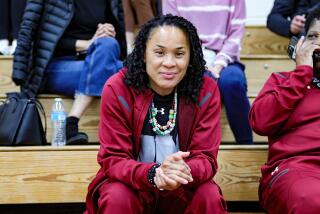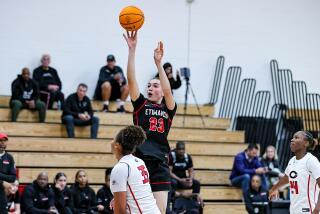A Net Gain in Prestige : Colleges: Christian Heritage, in search of a unifying identity, chose basketball to bring attention to the school.
EL CAJON — Students seldom develop an emotional bond with the likes of a math or English department, so the president of Christian Heritage College turned to basketball to unite the struggling and stagnant institution.
Enrollment at the sleepy nondenominational college in El Cajon had peaked at 500 in 1984, then eroded to 350 by the fall of 1985, its greatest loss since the school was founded in 1971.
Morale was cool, growing pains at the threshold, and CHC President David Jeremiah was eager to capture the attention of the campus.
“We wanted something our kids could rally around,” Jeremiah said. “I had never heard of anyone rallying around the biology department.”
What he chose was basketball, and in 1986, Christian Heritage fielded a team that went 9-19. Four years later, the Hawks are the top-ranked college in the 110-member National Christian Collegiate Athletic Assn. They have a 16-4 record and have won 13 of their past 14 games. Consider the student body captured.
Jeremiah chose basketball as the flagship sport, for reasons that began with his own undying love of the game (CHC now also fields men’s soccer and women’s volleyball teams).
“It was my own prejudice,” Jeremiah said of basketball. “It’s a great game. I knew a small college without a huge budget and not a lot of kids could do well and get excellent exposure. You can reach a level of excellence easily.”
Jeremiah sought out Jim Huckaby, then coach of Baptist Bible College of Pa., to come West and start the basketball program here.
Huckaby brought with him Ray Slagle, a 15-year veteran of coaching who in 1985 led Inter-City Baptist High School of Allen Park to Michigan’s Class D state championship. Jeremiah had already enlisted the help of former NBA center Swen Nater. Huckaby left after two years, and now Slagle and Nater--also the athletic director--are co-coaches.
“He was successful in starting four other programs,” Jeremiah said of Huckaby. “And he fulfilled (CHC’s needs) to a T.”
Jeremiah admitted that winning has generated the attention he craved.
“We expected to take our lumps the first few years,” he said, “but I’d be less than honest if I said it had come together faster than I thought it would.”
Said Nater: “The basketball team was started to make Christian Heritage known across the country. You can’t buy the kind of publicity that a winning team can get you. We have a very, very good school here, and I went to UCLA.”
Although Jeremiah doesn’t like to talk too much about winning, he knows losing would subject the basketball team to intense scrutiny.
“At a small college,” he said, “if a program isn’t validated real quick, people ask why are we doing it.”
What the people in admissions are asking is why it wasn’t a decade earlier in coming.
Cheryl McIntosh has been the assistant registrar at CHC for 5 1/2 years and has noticed a change of attitude on campus the past two. The Hawks were 24-9 in 1988-89.
“There’s more school spirit with the basketball team,” McIntosh said. “I think it’s been a tremendous thing. Kids have a more positive attitude now. There’s a lot more here for them to identify with.”
The students are identifying and sticking with the school. CHC had a 99% student retention rate from the fall to spring. “That’s almost unheard of,” she said. “It’s phenomenally high.”
Said Jeremiah: “Christian Heritage basketball has done more to bring our academic community together than anything else. We wanted to create a sense of camaraderie and it has done that.”
Not only has basketball united the student body of 340, it has created a loyal following in the community that grows with each game and each victory.
“The support has grown so much,” said Slagle, who estimates home crowds of approximately 800-900 a game at Grossmont College. “Every game we see people we’ve never seen before.”
That’s an accomplishment in itself, considering that teams with Christian affiliations often fight misconceptions about their basketball ability or the mission of the school.
“A good sports fan will ask questions,” Nater said. “Take UCLA and UCSD. There’s a big difference. It’s a lot in what the name connotes.
“Being NAIA, we’re not in the limelight as much. That’s just the way it is. We have no control over our (public relations). We just play ball and hope we win.”
And by winning, CHC draws the people whose only special interest is seeing a polished game.
“I don’t care if it’s some high school team no one’s ever heard of,” Nater said. “People will come and watch a winning team, getting behind a winner. That’s something people like to do.”
Former Division I players Mark Kraatz (senior guard) and Brad Soucie (senior center) played for Slagle’s Allen Park state championship team and have been an integral part of CHC’s current success. With freshmen Jeff Martin and Lance Roark, they form the pipeline of talent from Inter-City Baptist to El Cajon.
Kraatz said size alone leaves CHC at a distinct disadvantage--guard Will Cunningham is just 6-feet and CHC’s leading rebounder.
“Size is one criterion that’s hard to compensate for,” he said . . . but talent helps it make up for such deficiencies . . . “People don’t think basketball players have much talent at this level. I’d just like them to come see us. I’d like to play (U.S. International) and USD.”
Said Soucie: “I’m not saying we can go out and beat (San Diego State) or USD, but I think we’re one of the better (local) teams at all levels.”
Players, like all students at CHC, attend chapel three times a week excluding Sunday and have an 11 p.m. curfew on weekdays that is extended to midnight on weekends. They are expected to live a life style that is in line with the Biblical teachings of the college.
“We try to follow Biblical principles as far as morality goes, and rules on daily issues,” Slagle said. “We’re certainly opposed to drug usage, alcohol, and we like to be moderate in TV viewing, movie viewing and we’re concerned with language and music.”
Players and coaches agree that discipline and unselfishness have had a profound impact on CHC’s success.
“Even at a Christian college,” Kraatz said, “the decision about drugs and everything else is still there, but it’s nice knowing that everyone’s head is clear. I like to think it helps, but how much, I don’t know.”
Said Slagle: “There’s a correlation, I believe, to the rules and our success. Some discipline comes from the life style that we expect of them.”
Soucie said his two years at Eastern Michigan, where he set an NCAA playoff record with eight three-pointers against Pittsburgh, showed him a lot about, “looking out for No. 1.”
“Everyone looked out for himself,” Soucie said. “Even if you won, there was a lot of selfishness. It’s really encouraging here in the aspect that everyone’s pulling for everyone.”
But Slagle said the court never tries to replace the pulpit.
“We are not Bible teachers,” Slagle said. “Basketball is a time of application of what they’ve learned. We don’t spend a lot of time in a group, reading the Word or quoting verses. Living a life that’s pleasing to the Lord is much more effective than preaching.”
Soucie wears basketball shoes with “Jesus Saves” penned in and said he likes to use the game as a means to share his faith.
“I try to use basketball,” he said, “to get to the people who you wouldn’t reach otherwise.”
Kraatz said Illinois State, where he played one year, stressed good grades, but much of it was just talk. “It’s playing your best that counts, that’s easy to say,” Kraatz said, “but here, they really mean it.”
CHC follows a dab-of-this, a dash-of-that philosophy that steals from the best. Nater has implemented much of his training under John Wooden at UCLA. He and Slagle also have their own ideas.
Slagle admitted that the whole co-coaching arrangement is “a dysfunctional setup, but we’ve made the most of it in our situation. It allows each of us to look at individual situations and be specific about what affects our part of the team.”
Nater coaches defense and rebounding, and Slagle coaches the offense. Off court, Nater is the recruiting specialist, and Slagle concentrates on scouting. Slagle likened it to a marriage.
“If you care about the needs of the other person,” he said, “it works out.”
Players had to grow into the system as well.
“At first I wasn’t sure about it,” Soucie said. “But they do a good job of communicating and not contradicting each other.”
Said Slagle: “The kids struggled with it at first, but they believe now it works out well.”
Nater and Slagle also want their players (who carry a group 3.0 grade-point average) to think for themselves on the court.
“We believe the players play the game,” Slagle said. “It’s very important to see our guys develop an intellectual approach to the game. We play a very simple game and they have to dictate, once the game begins, how they will approach it.”
Both also agree on the importance of conditioning.
“The players take good care of themselves,” Nater said. “We don’t wear out. Like John Wooden’s teams at UCLA, we want to be the best-conditioned athletes in the country.”
Another Wooden throwback is the Hawks’ pride in playing a relentless and determined game.
“Another virtue of Swen being here is the Wooden influence,” Jeremiah said. “They always played hard and believed excellence was a No. 1 goal. Winning is important because it says we’re doing the things we need to do to get recognition.”
The winning is there, and the recognition is slowly coming. “The other day,” Soucie said, “I went into a 7-Eleven and some guy said, ‘Hey, you play for that good team.’ ”
A good team, still so new and so spirited, and still not sure just what to do with all its success.
“We really don’t even have a history yet,” Nater said. “Everything that’s happening is so incredible. It’s just God’s grace.”
More to Read
Get our high school sports newsletter
Prep Rally is devoted to the SoCal high school sports experience, bringing you scores, stories and a behind-the-scenes look at what makes prep sports so popular.
You may occasionally receive promotional content from the Los Angeles Times.






